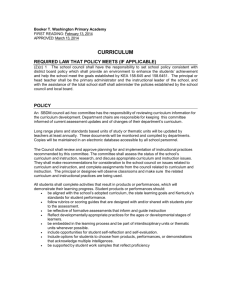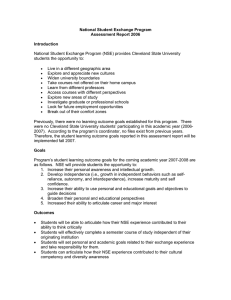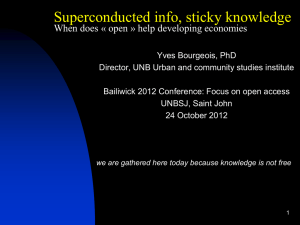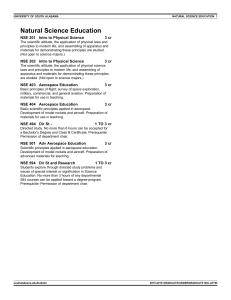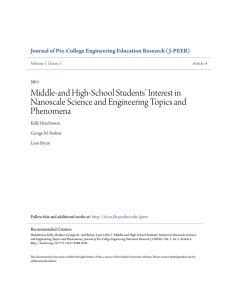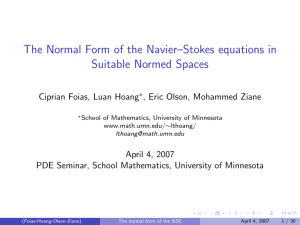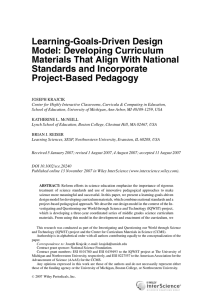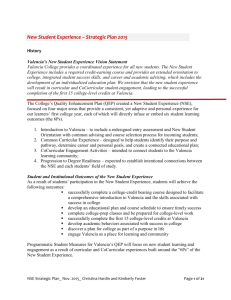NCLT Construct Centered Design
advertisement
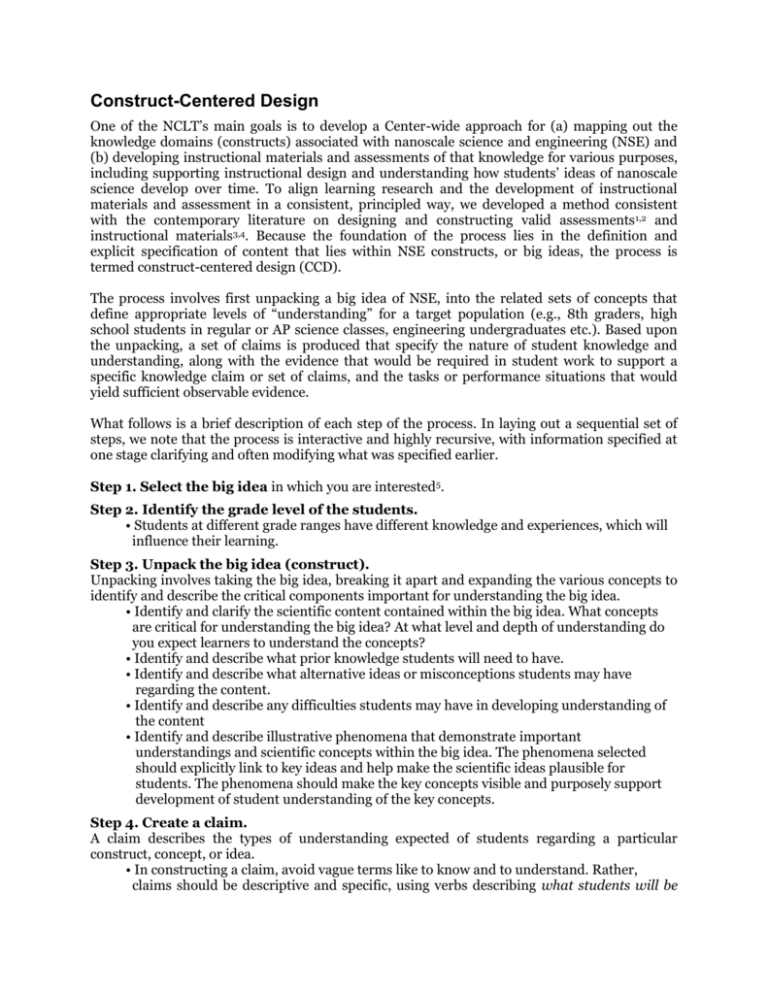
Construct-Centered Design One of the NCLT’s main goals is to develop a Center-wide approach for (a) mapping out the knowledge domains (constructs) associated with nanoscale science and engineering (NSE) and (b) developing instructional materials and assessments of that knowledge for various purposes, including supporting instructional design and understanding how students’ ideas of nanoscale science develop over time. To align learning research and the development of instructional materials and assessment in a consistent, principled way, we developed a method consistent with the contemporary literature on designing and constructing valid assessments 1,2 and instructional materials3,4. Because the foundation of the process lies in the definition and explicit specification of content that lies within NSE constructs, or big ideas, the process is termed construct-centered design (CCD). The process involves first unpacking a big idea of NSE, into the related sets of concepts that define appropriate levels of “understanding” for a target population (e.g., 8th graders, high school students in regular or AP science classes, engineering undergraduates etc.). Based upon the unpacking, a set of claims is produced that specify the nature of student knowledge and understanding, along with the evidence that would be required in student work to support a specific knowledge claim or set of claims, and the tasks or performance situations that would yield sufficient observable evidence. What follows is a brief description of each step of the process. In laying out a sequential set of steps, we note that the process is interactive and highly recursive, with information specified at one stage clarifying and often modifying what was specified earlier. Step 1. Select the big idea in which you are interested5. Step 2. Identify the grade level of the students. • Students at different grade ranges have different knowledge and experiences, which will influence their learning. Step 3. Unpack the big idea (construct). Unpacking involves taking the big idea, breaking it apart and expanding the various concepts to identify and describe the critical components important for understanding the big idea. • Identify and clarify the scientific content contained within the big idea. What concepts are critical for understanding the big idea? At what level and depth of understanding do you expect learners to understand the concepts? • Identify and describe what prior knowledge students will need to have. • Identify and describe what alternative ideas or misconceptions students may have regarding the content. • Identify and describe any difficulties students may have in developing understanding of the content • Identify and describe illustrative phenomena that demonstrate important understandings and scientific concepts within the big idea. The phenomena selected should explicitly link to key ideas and help make the scientific ideas plausible for students. The phenomena should make the key concepts visible and purposely support development of student understanding of the key concepts. Step 4. Create a claim. A claim describes the types of understanding expected of students regarding a particular construct, concept, or idea. • In constructing a claim, avoid vague terms like to know and to understand. Rather, claims should be descriptive and specific, using verbs describing what students will be able to do cognitively. This clarifies the nature of what they know or understand and how they know it. Step 5. Specify what evidence you will accept that a student has the desired knowledge. Evidence describes in detail the specific student behaviors, or performances, and/or work products that you would defend as indicative that the claim has been satisfied. • Specify the features of student products and performances that you expect to see and that form the basis for any judgment in support of the claim. Step 6a (assessment). Design particular tasks, questions or situations (assessment tasks) that will allow a student to respond in such a manner to generate data that will allow you to make a judgment about whether sufficient evidence exists to support the learning claim. • A single task or situation may provide evidence for more than one claim. • Multiple tasks may be necessary to assess a single claim. Step 6b (instructional materials). Design particular learning activities (learning tasks) that will support the development of student knowledge and skills such that they will be able to produce or execute the products, behaviors or performances that were deemed sufficient evidence to support the learning claim. Step 7a. Review assessment task(s). Factors to consider include: • Is the assessment task and context likely to be comprehensible to students? • Is the assessment task appropriately linked to knowledge required for understanding the desired knowledge? • Is the assessment task level-appropriate for students (e.g., content, language, etc.)? Step 7b. Review learning task(s). Factors to consider include: • Is the activity likely to be comprehensible to students? • Does the activity support the development of understanding of a key aspect of the big idea? • Do target students have the necessary prerequisite knowledge to do the activity? • Are students provided with the opportunity to practice using knowledge in a meaningful situation? • Are students provided with the opportunity to think about (and make sense of) what they've learned? References: 1- Pellegrino, J.W., Chudowsky, N., & Glaser, R. (Eds.). (2001). Knowing what students know: The science and design of educational assessment. Washington, DC: National Academies Press. 2- Mislevy R. J., Steinberg, L. S., Almond R. G., Haertel, G. D., & Penuel, W. R. (2003). Leverage points for improving educational assessment (PADI Technical Report. No. 2). Menlo Park, CA: SRI International [viewed electronically]. 3- Wiggins, G. P., & McTighe, J. (1998). Understanding by design. Alexandria, VA: Association for Supervision and Curriculum Development. 4- Krajcik, J.S., McNeill, K. L., & Reiser, B.J. (2007). Learning-goals-driven design model: Developing curriculum materials that align with national standards and incorporate project-based pedagogy. Science Education, 92(1), 1-32. 5- Stevens, S. Y., Sutherland, L., Schank, P., & Krajcik, J. (draft, 2007). The big ideas of nanoscience. Retrieved June 2, 2007 from http://hice.org/PDFs/Big_Ideas_of_Nanoscience-20feb07.pdf
